I have the next Sallen Key type filter

I have determined the transfer function and the coefficients of \$a_{0}\$ and \$a_{1̣̣}\$, based on
\$N(s)=\frac{Ka_{0}}{s^{n}+a_{n-1}s^{n-1}+....a_{1}s+a_{0}}\$
But then how do I use this to determine (or approximate) analytically what kind of response the filter has? (Butterworth, Chebyshev etc.)
This is besides making a frequency sweep using a simulator.
UPDATE
Derivating the transfer function.
I have named the node between the 47k resistances as \$V_{x}\$ and the node of the negative bias \$V_{y}\$
\$V_{out}=(1+\frac{R_{A}}{R_{B}})V_{y}\$
\$G=1+\frac{R_{A}}{R_{B}}=\frac{R_{A}+R_{B}}{R_{B}}\$
\$V_{y}=\frac{R_{B}}{R_{A}+R_{B}}V_{out}\$
Simplifying
\$V_{y}=\frac{V_{out}}{G}\$
using a voltage divider
\$V_{y}=\left(\frac{V_{x}}{R_{2}+\frac{1}{C_{2}s}}\right)\frac{1}{C_{2}s}=V_{x}\frac{1}{1+R_{2}C_{2}s}\$
\$V_{x}=(1+R_{2}C_{2}s)V_{y}\$
\$0=\frac{V_{x}-V_{in}}{R_{1}}+\frac{V_{x}-V_{y}}{R_{2}}+\frac{V_{x}-V_{out}}{\frac{1}{sC1}}\$
\$\frac{V_{x}-(1+R_{2}C_{2}s)V_{y}-V_{in}}{R_{1}}+\frac{(1+R_{2}C_{2}s)V_{y}-V_{y}}{R_{2}}+\frac{(1+R_{2}C_{2}s)V_{y}-V_{out}}{\frac{1}{sC1}}=0\$
\$\frac{(1+R_{2}C_{2}s)V_{y}}{R_{1}}-\frac{V_{in}}{R_{1}}+\frac{(1+R_{2}C_{2}s)V_{y}}{R_{2}}-\frac{V_{y}}{R_{2}}+\frac{(1+R_{2}C_{2}s)V_{y}}{\frac{1}{sC1}}-\frac{V_{o}}{\frac{1}{sC1}}=0\$
\$\frac{(1+R_{2}C_{2}s)V_{out}}{GR_{1}}-\frac{V_{in}}{R_{1}}+\frac{(1+R_{2}C_{2}s)V_{out}}{GR_{2}}-\frac{V_{out}}{GR_{2}}+\frac{(1+R_{2}C_{2}s)V_{out}}{\frac{G}{sC1}}-\frac{V_{o}}{\frac{1}{sC1}}=0\$
\$V_{out}\left[\frac{(1+R_{2}C_{2}s)}{GR_{1}}+\frac{(1+R_{2}C_{2}s)}{GR_{2}}-\frac{1}{GR_{2}}+\frac{(1+R_{2}C_{2}s)}{\frac{G}{sC1}}-\frac{1}{\frac{1}{sC1}}\right]=\frac{V_{in}}{R_{1}}\$
\$\frac{V_{out}}{G}\left[\frac{(1+R_{2}C_{2}s)}{R_{1}}+\frac{(1+R_{2}C_{2}s)}{R_{2}}-\frac{1}{R_{2}}+\frac{(1+R_{2}C_{2}s)}{\frac{1}{sC1}}-\frac{1}{\frac{1}{GsC1}}\right]=\frac{V_{in}}{R_{1}}\$
\$\frac{V_{out}}{G}\left[\frac{1}{R_{1}}+\frac{(R_{2}C_{2}s)}{R_{1}}+\frac{1}{R_{2}}+\frac{(R_{2}C_{2}s)}{R_{2}}-\frac{1}{R_{2}}+\frac{1}{\frac{1}{sC1}}+\frac{(R_{2}C_{2}s)}{\frac{1}{sC1}}-\frac{1}{\frac{1}{GsC1}}\right]=\frac{V_{in}}{R_{1}}\$
\$\frac{V_{out}}{G}\left[\frac{1}{R_{1}}+\frac{(R_{2}C_{2}s)}{R_{1}}+C_{2}s+sC1+sC1R_{2}C_{2}s-GsC_{1}\right]=\frac{V_{in}}{R_{1}}\$
\$\frac{V_{out}}{G}\left[\frac{1+R_{2}C_{2}s+R_{1}C_{2}s+R_{1}sC1+R_{1}sC1R_{2}C_{2}s-R_{1}GsC_{1}}{R_{1}}\right]=\frac{V_{in}}{R_{1}}\$
\$\frac{V_{out}}{G}\left[1+R_{2}C_{2}s+R_{1}C_{2}s+R_{1}sC1+R_{1}sC1R_{2}C_{2}s-R_{1}GsC_{1}\right]=V_{in}\$
\$\frac{V_{out}}{G}\left[s^{2}R_{1}R_{2}C1C_{2}+s(R_{1}C_{1}+R_{2}C_{2}+R_{1}C_{2}-GR_{1}C_{1})+1\right]=V_{in}\$
\$\frac{V_{out}}{G}\left[s^{2}R_{1}R_{2}C1C_{2}+s(R_{1}C_{1}-GR_{1}C_{1}+R_{2}C_{2}+R_{1}C_{2})+1\right]=V_{in}\$
\$\frac{V_{out}}{G}\left[s^{2}R_{1}R_{2}C1C_{2}+s(R_{1}C_{1}(1-G)+R_{2}C_{2}+R_{1}C_{2})+1\right]=V_{in}\$
\$\frac{V_{out}}{V_{i}}=\frac{G}{s^{2}R_{1}R_{2}C1C_{2}+s(R_{1}C_{1}(1-G)+R_{1}C_{2}+R_{2}C_{2})+1}\$
\$\frac{V_{out}}{V_{i}}=\frac{G}{s^{2}R_{1}R_{2}C1C_{2}+s(R_{1}C_{1}(1-G)+R_{1}C_{2}+R_{2}C_{2})+1}\$
\$\frac{V_{out}}{V_{i}}=\frac{\frac{G}{R_{1}R_{2}C1C_{2}}}{s^{2}+s(\frac{1}{R_{1}C_{1}}+\frac{1}{R_{1}C_{2}}+\frac{(1-G)}{R_{2}C_{2}})+\frac{1}{R_{1}R_{2}C1C_{2}}}\$
if \$R_{1}=R_{2}=R\$ and \$C_{1}=C_{2}=C\$
\$\frac{V_{out}}{V_{i}}=\frac{\frac{G}{R^{2}C^{2}}}{s^{2}+s(\frac{1}{RC}+\frac{1}{RC}+\frac{(1-G)}{RC})+\frac{1}{R^{2}C^{2}}}\$
\$\frac{V_{out}}{V_{i}}=\frac{\frac{G}{R^{2}C^{2}}}{s^{2}+s(\frac{(3-G)}{RC})+\frac{1}{R^{2}C^{2}}}\$
\$G=K\$
\$a_{0}=\frac{1}{R^{2}C^{2}}\$
\$a_{1}=\frac{3-G}{RC}\$